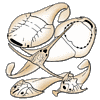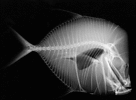Back to Profile Page
Tree of Life Media Contributed By Philippe Janvier
<<
<
1
2
3
>
>>
|
ID
|
Thumbnail |
Media Data |
| 4896 |

|
|
Comments
|
The inclusion of euconodonts in the vertebrates, or even craniates, is still controversial. Admittedly, the tissue structure of the "conodonts" (i.e; the denticles situated in their mouth; left) is at odds with conventional vertebrate hard tissues. Nevertheless, the eyes, body shape, and tail stucture of the euconodonta are strikingly vertebrate-like.
|
|
Reference
|
After Purnell et al. 1995
|
|
Image Use
|
 This media file is licensed under the Creative Commons Attribution License - Version 3.0. This media file is licensed under the Creative Commons Attribution License - Version 3.0.
|
|
Copyright
|
© 1997

|
|
Attached to Group
|
Conodonta: view page image collection
|
|
Title
|
euconodonta.gif
|
|
Image Type
|
Drawing/Painting
|
|
Image Content
|
Specimen(s), Body Parts
|
|
ID
|
4896
|
|
| 5202 |

|
|
Scientific Name
|
Hanyangaspis, Lungmenshanaspis, Sanchaspis, Eugaleaspis
|
|
Location
|
China and Vietnam
|
|
Comments
|
Galeaspids are known from the Silurian and Devonian of China and Vietnam. They are characterized by a large, median dorsal inhalent opening and a scallopped pattern of the sensory-lines. Their mouth and gill openings are situated on the ventral surface of the head (top right). In the most primitive forms, such as the Silurian genus Hanyangaspis (top), the median dorsal inhalent opening is broad and situated anteriorly. In other galeaspids, its is more posterior in position and can be oval, rounded, heart-shaped or slit-shaped. In some Devonian galeaspids, such as the hunanaspidiforms Lungmenshanaspis (middle) and Sanchaspis (bottom right), the headshield is produced laterally and anteriorly into slender processes. The eugaleaspidiforms, such as Eugaleaspis (bottom left) have a horseshoe-shaped headshield and a slit-shaped median dorsal opening, which mimates the aspect of the headshield of osteostracans.
|
|
Reference
|
Based on Liu, Y. H. (1975). Lower Devonian agnathans of Yunnan and Sichuan. Vertebrata PalAsiatica, 13, 215-223. (In Chinese with English summary.) and Pan, J. (1992). New Galeaspids (Agnatha) from the Silurian and Devonian of China. Geological Publishing House, Beijing.
|
|
Specimen Condition
|
Fossil -- Period: Silurian and Devonian
|
|
Image Use
|
 This media file is licensed under the Creative Commons Attribution License - Version 3.0. This media file is licensed under the Creative Commons Attribution License - Version 3.0.
|
|
Copyright
|
© 1997

|
|
Attached to Group
|
Galeaspida: view page image collection
|
|
Title
|
galeaspida.gif
|
|
Image Type
|
Drawing/Painting
|
|
Image Content
|
Specimen(s)
|
|
ID
|
5202
|
|
| 5468 |

|
|
Scientific Name
|
Doryaspis nathorsti
|
|
Location
|
Spitsbergen
|
|
Specimen Condition
|
Fossil -- Period: Lower Devonian
|
|
Image Use
|
 This media file is licensed under the Creative Commons Attribution License - Version 3.0. This media file is licensed under the Creative Commons Attribution License - Version 3.0.
|
|
Copyright
|
©

|
|
Attached to Group
|
Protopteraspididae (Pteraspidomorphi): view page image collection
|
|
Title
|
doryaspis.jpeg
|
|
Image Type
|
Photograph
|
|
Image Content
|
Specimen(s)
|
|
ID
|
5468
|
|
| 5477 |

|
|
Scientific Name
|
Selene vomer
|
|
Specimen Condition
|
Dead Specimen
|
|
Body Part
|
skeleton
|
|
Copyright
|
© 1995 Tierney Thys
|
|
Image Use
|
restricted
|
|
Attached to Group
|
Percomorpha: view page image collection
|
|
Title
|
selenexray.gif
|
|
Image Type
|
Photograph
|
|
Image Content
|
Specimen(s)
|
|
Technical Information
|
Radiograph
|
|
ID
|
5477
|
|
| 5526 |

|
|
Scientific Name
|
Eptatretus, Myxinikela
|
|
Comments
|
A modern hagfish, the Pacific hagfish Eptatretus (top), shows some of the diagnostic features of the group: the tentacles surrounding the snout, the left oesophagocutaneous opening (in the rear of the gill openings), and the series of large, ventrolateral slime glands. The earliest known fossil hagfish, Myxinikela, from the Late Carboniferous of Illinois, had a much stouter body shape but clearly shows the tentacles.
|
|
Reference
|
After Bardack, D. (1991). First fossil hagfish (Myxinoidea): a record from the Pennsylvanian of Illinois. Science 254:701-703.
|
|
Image Use
|
 This media file is licensed under the Creative Commons Attribution License - Version 3.0. This media file is licensed under the Creative Commons Attribution License - Version 3.0.
|
|
Copyright
|
© 1997

|
|
Attached to Group
|
Hyperotreti: view page image collection
|
|
Title
|
hyperotreti.gif
|
|
Image Type
|
Drawing/Painting
|
|
Image Content
|
Specimen(s)
|
|
ID
|
5526
|
|
Please note: Most images and other media displayed on the Tree of Life web site are protected by copyright, and the ToL cannot act as an agent for their distribution. If you would like to use any of these materials for your own projects, you need to ask the copyright owner(s) for permission. For additional information, please refer to the
ToL Copyright Policies.





 This media file is licensed under the
This media file is licensed under the 
 Go to quick links
Go to quick search
Go to navigation for this section of the ToL site
Go to detailed links for the ToL site
Go to quick links
Go to quick search
Go to navigation for this section of the ToL site
Go to detailed links for the ToL site